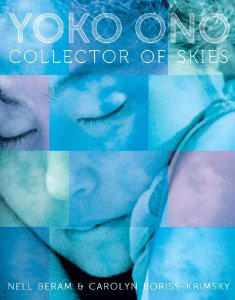For almost 80 years, Kirkus Reviews has served as the industry bible for bookstore buyers, librarians, and ordinary readers alike. Now Popdose joins the Kirkus Book Bloggers Network to explore the best — and sometimes the worst — in pop-culture and celebrity books.
This week, a gorgeous book for young readers considers an artist in her own right whom we usually think of as half of a famous pair…
 And so this is Christmas — or near enough, anyway — and what have you done? Maybe you’ve spent an afternoon trimming your tree. Maybe you’ve baked some cookies to share. And maybe you’ve listened to the radio; and there’s Yoko Ono’s voice, behind John Lennon’s. Though she’s been making art and music on her own for more than half a century, this is about the only time of year you stand a chance of hearing her — in the chorus of a holiday song, singing with her superstar husband.
And so this is Christmas — or near enough, anyway — and what have you done? Maybe you’ve spent an afternoon trimming your tree. Maybe you’ve baked some cookies to share. And maybe you’ve listened to the radio; and there’s Yoko Ono’s voice, behind John Lennon’s. Though she’s been making art and music on her own for more than half a century, this is about the only time of year you stand a chance of hearing her — in the chorus of a holiday song, singing with her superstar husband.
Now, that may not be just, but it’s surely unsurprising. Lennon himself called Ono ”the word’s most famous unknown artist.” Her association with him made her a household name, but only a tiny fraction of those who knew that name ever became familiar with her work. The forthcoming Yoko Ono: Collector of Skies, by Nell Beram and Carolyn Boriss-Krimsky, aims to introduce a new generation of young readers to her life and art.
The notion of a children’s book about Yoko Ono may sound, to some people, like a punchline to an off-color joke. But it makes a certain sense. Ono’s best and most enduring work — her poems, performances and especially her conceptual pieces — are immediately accessible to kids. Indeed, they are predicated on a wide-eyed, childlike perspective. Belying the popular image of Ono as a stonefaced diva of the avant-garde, her approach has always been playful. Her greatest achievement as an artist has been in making herself — her perspective, her attitude, her point of view — into an artistic project. Her work constitutes a set of operating instructions for the universe.
Naturally, given the audience, the authors spend quite a bit of time on Ono’s own youth. It’s an enlightening read. Clearly, Ono’s imagination was shaped by her childhood experiences. Born in 1933, the first child of a well-to-do couple — father a rising bank executive, mother descended from one of the country’s most prestigious families — she grew up shuttling between Japan and America.
She was expected by her parents to be independent from a young age, and reared by a series of nannies. Ono’s parents were glamorous, rather distant figures. Art and music formed a common ground where they could relate, but even there the connections were difficult. Her father, Eisuke Ono,was a fine pianist, and had been an aspiring composer before taking up finance in accordance with his own father’s deathbed request. Eisuke approved of Yoko’s musical studies, but discouraged her interest in composition (which he viewed as men’s work), steering her instead towards vocal music and German lieder. Ono’s mother Isoko was herself a frustrated painter, and seized upon young Yoko’s projects as a way of fulfilling her own ambitions under the guise of ”helping” her daughter. It is no wonder that Ono turned away from classical music and traditional visual art towards something that she could truly make her own.
Read the rest of this article at Kirkus Reviews!





Comments